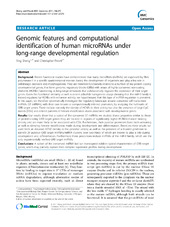| dc.contributor.author | Sheng, Ying | eng |
| dc.contributor.author | Previti, Christopher | eng |
| dc.date.accessioned | 2012-01-24T09:25:19Z | |
| dc.date.available | 2012-01-24T09:25:19Z | |
| dc.date.issued | 2011-05-27 | eng |
| dc.Published | BMC Genomics 2011, 12:270 | en |
| dc.identifier.issn | 1471-2164 | |
| dc.identifier.uri | https://hdl.handle.net/1956/5511 | |
| dc.description.abstract | Background: Recent functional studies have demonstrated that many microRNAs (miRNAs) are expressed by RNA polymerase II in a specific spatiotemporal manner during the development of organisms and play a key role in cell-lineage decisions and morphogenesis. They are therefore functionally related to a number of key protein coding developmental genes, that form genomic regulatory blocks (GRBs) with arrays of highly conserved non-coding elements (HCNEs) functioning as long-range enhancers that collaboratively regulate the expression of their target genes. Given this functional similarity as well as recent zebrafish transgenesis assays showing that the miR-9 family is indeed regulated by HCNEs with enhancer activity, we hypothesized that this type of miRNA regulation is prevalent. In this paper, we therefore systematically investigate the regulatory landscape around conserved self-transcribed miRNAs (ST miRNAs), with their own known or computationally inferred promoters, by analyzing the hallmarks of GRB target genes. These include not only the density of HCNEs in their vicinity but also the presence of large CpG islands (CGIs) and distinct patterns of histone modification marks associated with developmental genes. Results: Our results show that a subset of the conserved ST miRNAs we studied shares properties similar to those of protein-coding GRB target genes: they are located in regions of significantly higher HCNE/enhancer binding density and are more likely to be associated with CGIs. Furthermore, their putative promoters have both activating as well as silencing histone modification marks during development and differentiation. Based on these results we used both an elevated HCNE density in the genomic vicinity as well as the presence of a bivalent promoter to identify 29 putative GRB target miRNAs/miRNA clusters, over two-thirds of which are known to play a role during development and differentiation. Furthermore these predictions include miRNAs of the miR-9 family, which are the only experimentally verified GRB target miRNAs. Conclusions: A subset of the conserved miRNA loci we investigated exhibits typical characteristics of GRB target genes, which may partially explain their complex expression profiles during development. | en_US |
| dc.language.iso | eng | eng |
| dc.publisher | BioMed Central | eng |
| dc.rights | Attribution CC BY | eng |
| dc.rights.uri | http://creativecommons.org/licenses/by/2.0/ | eng |
| dc.title | Genomic features and computational identification of human microRNAs under long-range developmental regulation | eng |
| dc.type | Peer reviewed | eng |
| dc.type | Journal article | eng |
| dc.description.version | publishedVersion | |
| dc.rights.holder | Copyright 2011 Sheng and Previti; licensee BioMed Central Ltd. | |
| dc.identifier.doi | https://doi.org/10.1186/1471-2164-12-270 | |
| dc.identifier.cristin | 844898 | |
| dc.subject.nsi | VDP::Mathematics and natural science: 400::Basic biosciences: 470::General microbiology: 472 | eng |



